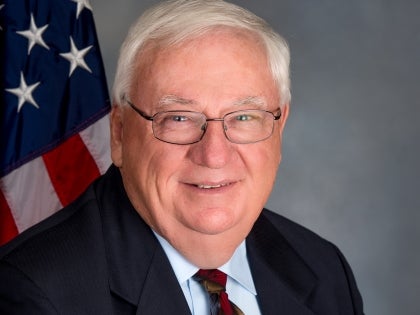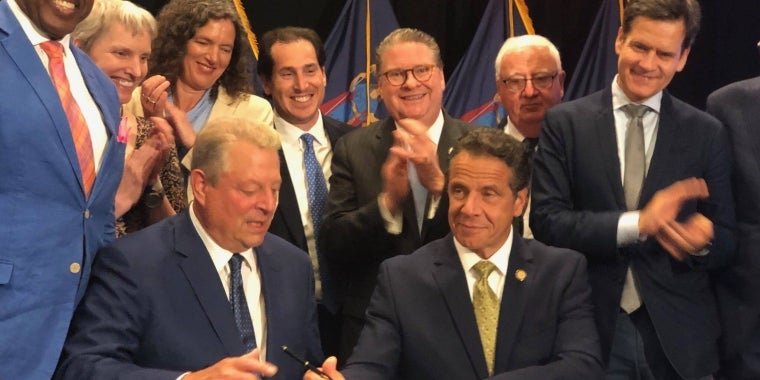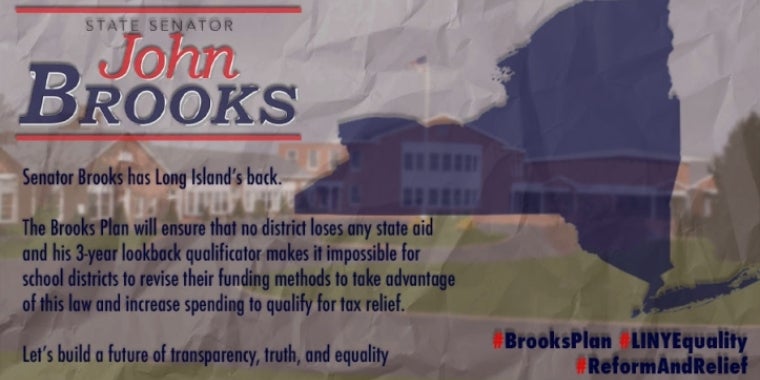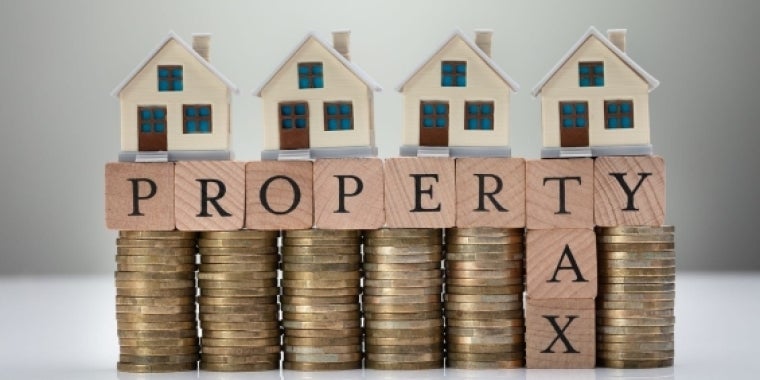
New York's Climate Change Bill is Law

NEW YORK — Gov. Andrew Cuomo on Thursday signed a long-debated bill aimed at combating climate change that will alter the face of energy production and other parts of the economy across New York state in coming decades.
“Cries for a new green movement are hollow political rhetoric if not combined with aggressive goals and a realistic plan on how to achieve them,” Cuomo said as he signed the Climate Leadership and Community Protection Act in a ceremony at Fordham law school in New York City.
The law aims to put the Empire State at the forefront of efforts to reduce greenhouse gases by supercharging the shift to renewable energy and cutting the use of fossil fuels in power production and other pursuits.
It's known as New York's version of a Green New Deal, a measure some Democratic presidential contenders and members of Congress are pushing on a national level that would enlist the federal government to shift priorities away from the use of fossil fuels.
With Donald Trump in the White House, however, that’s unlikely to happen anytime soon. Cuomo, who was joined by fellow Democrat and former Vice President Al Gore, issued lots of contrasts between the federal lack of action and New York’s bill when it comes to battling climate change.
“Our is the real deal,” said Cuomo, who also said that it was not “politically convenient” for Trump to acknowledge or deal with the issue. It wasn’t lost on audience members, who sporadically cheered, that Gore helped put climate change front and center for many Americans with his 2006 film “An Inconvenient Truth” that illustrated stark examples of a changing and warming global climate.
While Gore pointed to a climate he says has changed even more since his film, he noted that there’s been a steady shift toward using more renewable fuel.
“We still have it within our power to grab hold of this crisis,” Gore said.
The New York climate bill sets out a series of goals to reduce the use of carbon-based fossil fuels and lower greenhouse gas emissions by certain dates.
By 2030, 70 percent of the state's electric generation is supposed to be from renewable sources like wind, solar or hydropower. And by 2040 electric generation is supposed to reach zero emissions. Greenhouse gas is likewise supposed to be reduced by 85 percent by 2050 compared with 1990 levels.
Getting there will require a major, rapid shift in energy sources from the state’s traditional mix of natural gas and nuclear power, as well as existing and relatively clean hydropower, to more wind and solar power.
Environmentalists praised the move. The bill had been proposed in prior years but didn’t get approved until this past legislative session when Democrats took control of the state senate as well as assembly.
“Today, New York begins its official breakup with fossil fuels. Under the Climate Leadership and Community Protection Act, New York will both slash climate pollution and provide a playbook for the rest of the nation,” said Peter Iwanowicz, executive director of Environmental Advocates of New York. “How fitting that the Empire State is once again leading the way.”
Still, some emphasized that reaching the goal set out by this legislation would take sustained effort and vigilance to ensure that the goals of drastically lowering greenhouse gas emissions were on schedule. And it will mean resisting the well-financed entreaties of numerous entrenched lobbying and political interests that back traditional sources of power.
“This is when New York residents most need him to be a micromanager, daily providing leadership to overcome the multiple barriers that impede the state moving to 100 percent renewables,” Mark Dunlea, chairperson of the Green Education and Legal Fund, said of Cuomo.
“We have not seen that from any of New York's governors over the last 17 years as N.Y. has managed to only get 5 percent of the state’s electricity from wind and solar since Pataki first set climate goals in 2002." Dunlea continued. "We now have to match or exceed that output annually.”
“At least three other similar statewide renewable energy plans have proved embarrassingly unsuccessful since 2004,” added Walter Hang, who operates Toxics Targeting, an organization that identifies pollution sources. He believes there should be more focus on energy savings and efficiency that could stem from widespread retrofitting,
At the same time, business leaders and energy producers have warned that the goals could lead to sharply higher electricity costs for New York consumers.
The Empire Center, a fiscally conservative watchdog group, noted that the offshore wind power projects slated for the next few years will require large subsidies from ratepayers across the state, even though those projects will supply power to Long Island and New York City.
Others stressed the sheer size of the changes required in New York's power infrastructure.
"Reaching the state's ambitious goals will require unprecedented levels of investment in the electric system and near-complete electrification of the transportation, residential and commercial sectors," said Gavin Donohue, president and CEO of the Independent Power Producers of New York, a trade group of power plant operators.
"New investment will be needed in renewables, transmission, energy storage and, most critically, power generation capable of providing reliable and dispatchable electric service during extended periods where the wind does not blow and the sun does not shine," he said.
The changes won’t happen immediately. Cuomo and legislative leaders now will appoint a 22-member Climate Action Council, including state agency commissioners. The group will have three years to devise a broad plan for reaching carbon reduction goals. They’ll look at a range of industries like transportation, agriculture, manufacturing and housing, and create mandates for energy use.
While Trump has repeatedly said he doesn’t think global warming is real, studies indicate the planet overall, is warming.
The Union of Concerned Scientists, for instance, predicts that, absent changes, Albany County could see 11 days of 100-plus heat index, where if feels like it’s more than 100 degrees with the humidity, between 2036 and 2065.
In the near term, the forecast for Friday and Saturday in the Capital Region is calling for temperatures in the mid to upper 90s with a heat index ranging from 105 to 110 degrees, according to the National Weather Service in Albany.
There were no such days between 1971 and 2000.
Along with the climate bill, Cuomo also announced plans for starting what would be the nation’s largest offshore wind production effort. Two generators, off the coast of Long Island and New York City, are going to be built over the next few years.
By 2024 they should produce 1,700 megawatts of electricity, which could power more than 1 million homes. The Indian Point nuclear plant in Westchester, Cuomo noted, generates about 2 megawatts. Because there are no emissions, some northern New York plants will remain open and be part of the carbon-free mix. Indian Point, though is scheduled to close in the next several years.
Despite the challenges, Gore said it made sense that New York would forge ahead on the nation’s most ambitious climate goals.
“The politics of New York state is about as rough and tumble a version of politics that you will find anywhere,” Gore said, with his remark sparking applause and cheers.
“But somehow at the end of the day this vibrant political culture that is so alive and well in this state rises up and yield results.”



